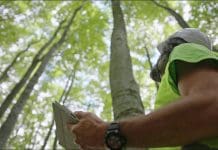James Jackson, Head of Training and Education with the Faculty of Party Wall Surveyors details the issue of security within the Party Wall etc. Act 1996…
The significance and importance of Section no. 12 of the Party Wall etc. Act 1996 received a considerable degree of prominence when the case of Kaye v Lawrence (Geoffrey Kaye – Appellant) v (Mathew Lawrence – Respondent) came before the courts. The case was heard in the Queen’s Bench Division of the High Court (Technology and Construction Court) and arose as a right of appeal under the Party Wall etc. Act 1996. In this case Mr. Justice Ramsey sat as a County Court Judge in the Central London Civil Justice Centre.
The appeal considered a comment on section 12 (2) of the Act drawn from the Green Book produced by the Pyramus and Thisbe Club which asserted that “security can only be requested if the building owner intends to exercise rights “conferred by this Act” i.e. he is proposing to carry out some work to the adjoining owners land or property. If he is simply excavating his own land then the adjoining owner has no right to receive security under this section.”
The principal issue raised within this appeal from an award under the 1996 Act is whether security can be requested when works are to be carried out on the building owners own land and not just when works are to be carried out on land of the adjoining owner, as was suggested by the commentary within the Green Book
In this case, Mr. Geoffrey Kaye, was an adjoining owner of a modern property which had a glass facade and Mr. Mathew Lawrence was a building owner of an adjacent site where he intended to carry out some construction works and duly served notices upon Mr. Kaye under section 6 (1) and 6 (2) of the 1996 Act of his intentions to do so. Within the Notices he stated that “it is not proposed to underpin or otherwise strengthen the foundations of your building”.
After dissenting from the Notices, Mr. Kaye and Mr. Lawrence both appointed their own surveyors and subsequently selected a third surveyor in accordance with the established procedures for resolving party wall disputes.
Legal representation presenting the case for the appellant maintained that there is no differentiation between work carried out on the adjoining owners land and that carried out on the building owners land, and in this case, damage could arise from excavation on the building owners land because of the nature of the soils and the scope of the basement works and gives rise to the need for security much more than would otherwise be carried out on the adjoining owners property. Therefore, it was argued that the third surveyor’s award which did not require the provision of security under section 12 (1) was wrong.
The judgment laid down in this case concluded that there was no ambiguity within the interpretation of the Act as had been argued by the Respondents’ legal representative and that despite the argument to the contrary that section 12 (1) of the Act did not apply to work under sections 6 (1) and 6 (2) and subsequent consideration given to the content of the judgment it has been concluded that there is no sensible reason to distinguish between work on an adjoining owners land and that of the building owners land. Accordingly, rights to building owners must apply equally to all notifiable works and cannot be compartmentalised for the sake of creating a legal nicety and one of segregation for the sake of exercising an act of sectional convenience.
Therefore, the appropriate interpretation of section 12 (1) of the Act should allow an adjoining owner to serve notice requiring the building owner before he begins any notifiable works to give such security as may be agreed between the owners. It goes without saying that section 10 of the Act also exists for the resolution of any disputes between owners in the event of them not being able to agree upon, firstly, the need for, and secondly the amount of security which may be decided upon.
Section 12 of the Act also goes on to state that if there are any elements of the notifiable works which are to be undertaken by the adjoining owner, the reversal of the procedure for providing security shall apply and the building owner may seek such security as may be agreed between the owners or in the event of a dispute arising be determined in accordance with section 10 of the Act.
However, section 12 of the Act does not prescribe in what manner such security is to be provided and established practice has historically considered the purchase of a security bond as being a well understood means of making such provision. However, it has often proved to be quite a time consuming process and generally requires the involvement of legal representatives and a cumbersome arrangement with the building owners’ bank.
A more modern and efficient manner of providing security is for an arrangement to be made for the provision of an escrow agreement to be drawn up by a person, or more likely, a company licensed by the Financial Standards authority to mitigate the risk of mismanagement of monies administered by the escrow agent.
Quite simply, an escrow agent will hold the agreed sum of money (generally from funds provided by the building owner) within an account entirely separate from any other monies and charge an amount (normally an agreed lump sum) until he is directed to release the monies, in whole or in part, back to the building owner when directed to do so either by the appointed surveyors of the third surveyor as the case may be. The surveyors may, alternatively, direct the escrow agent to pay some or all of the funds held by him to the adjoining owner as directed by the surveyors rather than release payment back to the building owner in the event of the cost of defects or incomplete works having to be undertaken.
The principal defect within the withholding of monies within an escrow account, however, is the need for a building owner to set aside a greater sum of money for this purpose than the basic cost of his proposed building works and consequently, this may thwart the more ambitious nature of certain projects, but, nevertheless, it is now an established means of providing security under section 12 of the party wall etc. Act 1996. ■
. . . . . . . . . . . . . . . . . . . . . . . . . . . . . . . . . . . . . . . . . . . . . . .
James Jackson FFPWS
Head of Training and Education
The Faculty of Party Wall Surveyors
Tel: 01424 883300
enq@fpws.org.uk
















